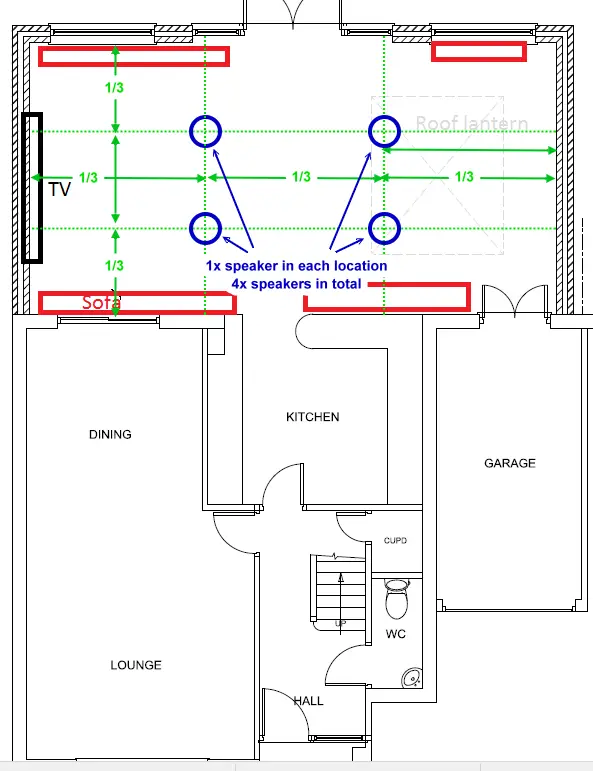There is science in terms of speaker placement. The black art comes in the application of that science in relation to the compromises required for real world applications 

If there's no need to consider furniture arrangements and seating positions then the rough rule of thumb is 1/3rds and 1/5ths. I'll explain....
Every room has a set of frequencies where the room resonates. Resonance is where the sound seems to boom. These frequencies are governed by the dimensions of the room; so there's on frequency for the length, one for the width and one for the height. We call these the fundamentals. The bigger the room then the lower those frequencies will be. The fundamentals for your room length and width (and based on a standard 2.4m ceiling height) are roughly 19Hz, 36.5Hz, and 72Hz. If you generate each of those tones and stand in the exact centre of the room then they'll sound incredibly loud, and as you move from the centre they'll die away to almost nothing at certain points. The result is that the sound changes a lot depending on where a person is sitting or standing for those frequencies.
Each frequency then has a series of harmonics. If you haven't come across harmonics before then the easiest way to think about them is to look at what happens when a guitar string is stopped at various points along the neck. The whole length of the string when plucked is the fundamental. Stop the string exactly half way along its length and pluck it then you hear the first harmonic. Do it at 1/4 and that's the second harmonic and so on. Rooms have harmonics too. Divide any room dimension in to even fractions (1/4, 1/8 and so on) then you'll be sat at one of the higher harmonics for that length.
So now you know the physics then here's how this applies to speaker and seating placement in rooms...
Even fractions are bad acoustically. Don't put your speakers in at 1/2 or 1/4 or 1/8th position of the length or width. All it will do is excite the room resonant modes and make certain frequencies boomy. Equally, don't arrange your seating so that listeners will end up sat with their heads at 1/2, 1/4, 1/8th etc of the length or width. What you should do instead is aim for speakers and listeners to be at the odd fractional lengths instead. So a 4.7m width means placing the centre of the speakers at 4.7/3 (1.56m) from the front or back walls. A 9m length means 3m from the side walls.
What you'll often find though is that there are joists or lighting in the way. In that case then go for the next nearest odd multiple (1/5th).
If there's no need to consider furniture arrangements and seating positions then the rough rule of thumb is 1/3rds and 1/5ths. I'll explain....
Every room has a set of frequencies where the room resonates. Resonance is where the sound seems to boom. These frequencies are governed by the dimensions of the room; so there's on frequency for the length, one for the width and one for the height. We call these the fundamentals. The bigger the room then the lower those frequencies will be. The fundamentals for your room length and width (and based on a standard 2.4m ceiling height) are roughly 19Hz, 36.5Hz, and 72Hz. If you generate each of those tones and stand in the exact centre of the room then they'll sound incredibly loud, and as you move from the centre they'll die away to almost nothing at certain points. The result is that the sound changes a lot depending on where a person is sitting or standing for those frequencies.
Each frequency then has a series of harmonics. If you haven't come across harmonics before then the easiest way to think about them is to look at what happens when a guitar string is stopped at various points along the neck. The whole length of the string when plucked is the fundamental. Stop the string exactly half way along its length and pluck it then you hear the first harmonic. Do it at 1/4 and that's the second harmonic and so on. Rooms have harmonics too. Divide any room dimension in to even fractions (1/4, 1/8 and so on) then you'll be sat at one of the higher harmonics for that length.
So now you know the physics then here's how this applies to speaker and seating placement in rooms...
Even fractions are bad acoustically. Don't put your speakers in at 1/2 or 1/4 or 1/8th position of the length or width. All it will do is excite the room resonant modes and make certain frequencies boomy. Equally, don't arrange your seating so that listeners will end up sat with their heads at 1/2, 1/4, 1/8th etc of the length or width. What you should do instead is aim for speakers and listeners to be at the odd fractional lengths instead. So a 4.7m width means placing the centre of the speakers at 4.7/3 (1.56m) from the front or back walls. A 9m length means 3m from the side walls.
What you'll often find though is that there are joists or lighting in the way. In that case then go for the next nearest odd multiple (1/5th).




